What Is the Strongest Type of Compositional Path in Art History
"Good composition is like a suspension bridge - each line adds strength and takes none away. No i is an artist unless he carries his picture in his head before painting it, and is sure of his method and composition." Robert Henri
This is a detailed guide on composition. I'll comprehend:
- What Is Composition in Fine art?
- Composition in Two Questions
- Composition Versus Copying the Reference
- Visual Elements (The Building Blocks of a Painting)
- Principles of Fine art (The Glue Holding It Together)
- Composition Rules, Theories, and Techniques
- Breaking the Rules
- Common Composition Issues
- Composition Breakdown Checklist
- Primary Painting Examples
- Key Takeaways
- Resources
(If y'all don't take time to read this now, you can download a PDF version for later here.)
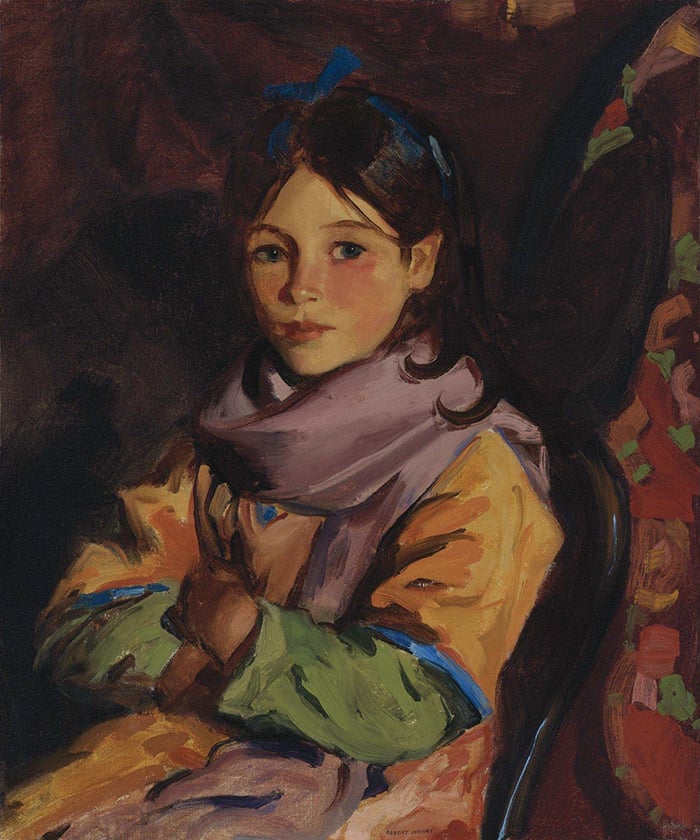
Robert Henri, One of the Children of Dooagh, 1924
Composition is a broad term. So broad it can be difficult to conspicuously articulate and define. I similar to think of it as the manner in which we accommodate the visual elements to communicate our ideas about the subject area.
A well-composed painting is clear, concise, and interesting. All the pieces will appear to work in perfect harmony. It will look like a cohesive painting, rather than an arrangement of parts.
A poorly composed painting is harder to spot. A painting can be wrong for many reasons and it can be hard to narrow down on the main culprit. You might know something is off, just be unable to put your finger on what.

Joseph Mallord William Turner, Snow Tempest
Composition theory can be distilled downward to two basic questions:
- What practice you want to say? (What is your large idea? What is the bulletin you want to communicate through your work?)
- How are you going to say it? (How are you going to arrange the visual elements in a way that communicates your message?)
I'll give yous an example. Here's a photo I want to paint:

What do I desire to say? I want to capture the beautiful contrast between warm lights and cool shadows... the interesting design of the overhanging tree branches and leaves... the turquoise blue of the water.
How am I going to say it? I need to ensure the lights are distinct from the shadows. Contrast is key. I'll use cleaved color and thick texture for the branches and leaves. I'll simplify the "noise", particularly in the shadows. I'll push the color in the shadows—purples, blues, and greens rather than blacks, browns, and grays.
Information technology's easy to become lost in all the composition rules and theories. So always try to bring it back to these two questions.
Doing this volition likewise give you more focus and management going into a painting. Virtually composition mistakes happen due to a lack of direction. You kickoff a painting with a certain vision, just so something else catches your eye and yous pursue that. It's not long before your initial vision is completely lost and your painting is a dislocated mass of ideas. Robert Henri has a bang-up section on this in his book,The Fine art Spirit. Here's an extract:
"To start with a deep impression, the best, the about interesting, the deepest y'all can have of the model; to preserve this vision throughout the piece of work; to come across nothing else; to admit of no digression from it; choosing but from the model the signs of it; volition lead to an organic work." The Art Spirit, Page 17
It's worth noting the distinction between composing a painting and merely copying the reference. Many artists go to not bad lengths to re-create the reference with complete accurateness. But, y'all don't get points for existence able to copy the reference. People don't meet what you painted from, they only see your painting. Then your painting must be able to stand up on its ain.
In that location will be times when you should depart from the reference. Perhaps at that place'south something near it that doesn't read well, is misleading, or doesn't fit with the remainder of your painting. Your artistic license gives you lot the privilege to ignore, add or change the reference every bit needed.
For case, beneath is my Maryvale, Foggy Morn plus the reference photo. The painting stands on its own. I didn't copy the reference photo, rather, I used it as a guide and to spark my initial impressions of the scene.
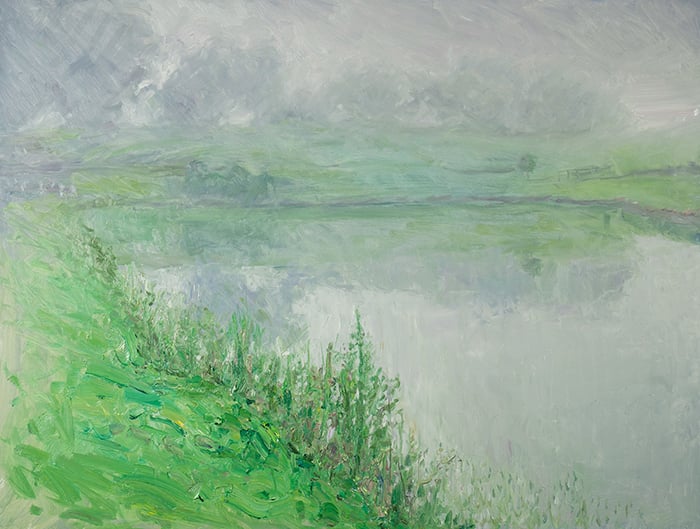
Dan Scott, Maryvale, Foggy Morning time, 2021

The visual elements are the building blocks of a painting and your tools of composition. They are
Line: A narrow marker that spans betwixt two points. This is the nigh cardinal visual element at your disposal.
Shape: A contained expanse defined past edges.
Color: The dissimilar hues (red, blue, orange, light-green—these are dissimilar hues).
Texture: How crude, shine, glossy, etc. the surface is. This could be the physical texture of your paint or the mere illusion of texture in your painting.
Value: How low-cal or dark a colour is.
Space: The space taken up by (positive) or betwixt (negative) objects.
Depth: The illusion of altitude on a flat surface. Depth is typically segmented into a foreground, centre ground, and background.
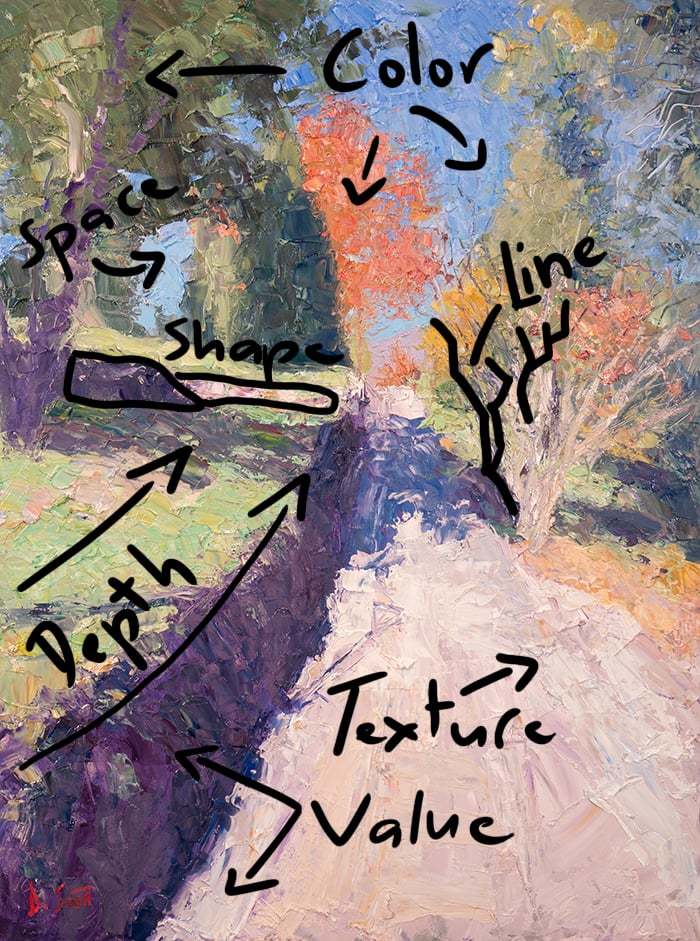
Dan Scott, New Zealand, Stroll in the Park, 2021
If the visual elements are the edifice blocks, the principles of fine art are the glue belongings it all together. They are:
Rhythm:The visual tempo of your work created through repetition and blueprint.
Balance: The visual weighting of elements.
Emphasis:The organisation of elements to place emphasis on certain areas. Otherwise known equally a focal point.
Gradation:A gradual modify in a sure element to help connect the composition (long lines to short lines, big shapes to small shapes, dark to light tones, etc.).
Harmony: The manner distinct parts work together towards a similar vision or idea.
Variety:The utilise of different elements to create interest and contrast.
Movement:The illusion of movement through clever placement of the visual elements (recall of Vincent van Gogh's energetic brushwork).
Proportion:The relative size of one element in comparing to another.
A word of warning: Don't go caught up on these definitions. Yous don't need to memorise them. They merely help us describe and articulate composition. Always bring it back to the 2 questions: What practise you want to say and how are you going to say it?
There are several rules, theories, and techniques that tin can assist you craft more interesting compositions. Below are some of the of import ones. Keep in mind, these are not to be treated as rule-leap police force. Rather, they are suggestions or guidelines at best.
Framing
Framing involves arranging shapes and other elements in a manner that "frames" a detail expanse. The thought backside information technology is much the same as why nosotros physically frame our paintings. It helps focus and contain our attention.
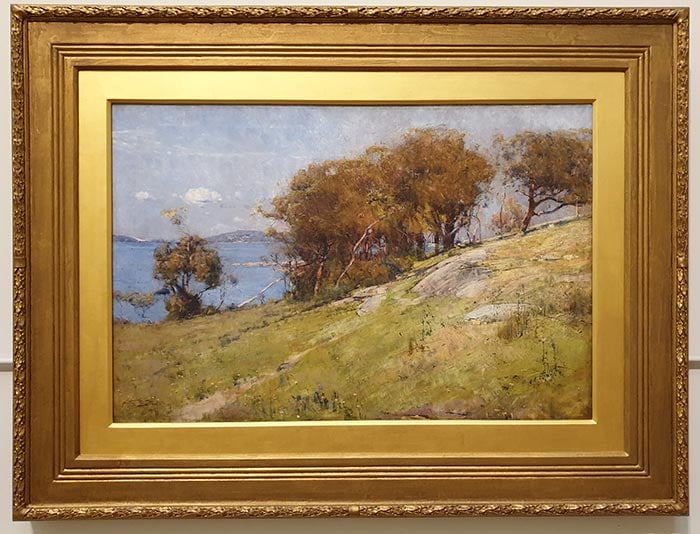
Arthur Streeton, Cremorne Pastoral, 1895
In Edgar Payne's stunning mural below, the high-key background is framed by the trees in the foreground.
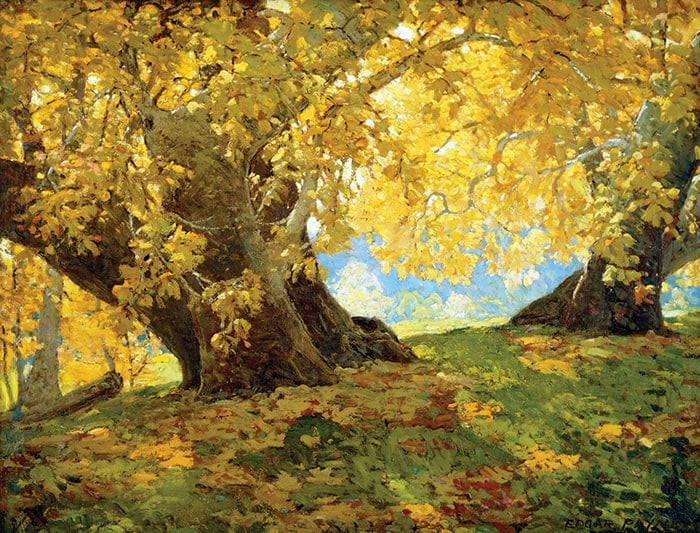
Edgar Alwin Payne, Sycamore in Autumn, Orangish Canton Park, c.1917
I did a similar affair in my painting,Wellington Point, High Contrast.

Dan Scott, Wellington Point, Loftier Contrast 2021
Below is a more obvious case, with a window framing the landscape in the groundwork.

Pierre Bonnard, Open Window Towards the Seine (Vernon), 1912
Tip: You don't need to attempt and artificially create frames in your subject. Instead, consider how you can adapt and depict what is already there to frame of import features. For example, a prominent tree could be used to frame the left side of your painting.
Leading Lines
Leading lines are suggestive lines that straight attending around a painting. They can exist actual lines or implied lines that don't physically exist but are only implied or suggested. A line of vision is an implied line. Encounter John Singer Sargent's painting below. We want to look where he is looking.
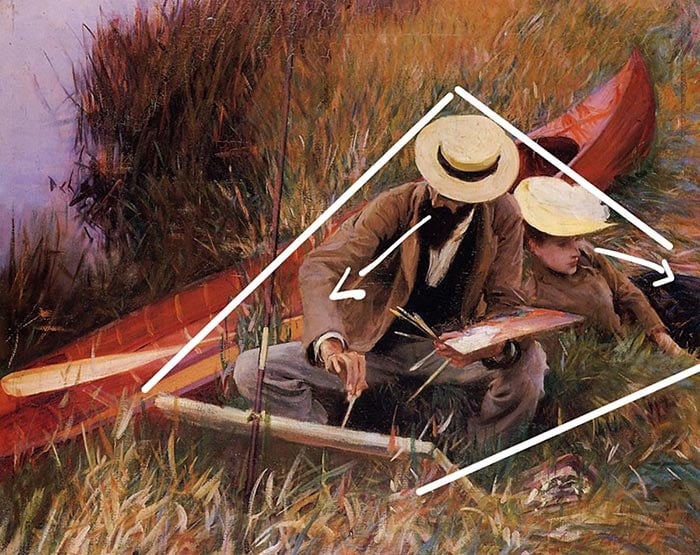
John Vocalist Sargent, Paul Helleu Sketching His Wife, 1889
Golden Ratio
"Without mathematics there is no art." Luca Pacioli
The gilt ratio is approximately 1 to ane.618. Designs that follow the gilded ratio are generally considered to exist aesthetically pleasing.
I won't go into particular on the aureate ratio, equally I consider the rule of thirds (discussed below) to be a more practical application of the concept. If y'all want to acquire more than about the golden ratio, check out this mail service: Using The Golden Ratio (AKA Gilt Mean).
Rule of Thirds
The rule of thirds involves placing a three-past-three filigree over the subject and using it to assist in the limerick design. The gridlines and intersections are "safe" spots to position fundamental features. For example, you could position your focal point at one of the intersections, or the horizon line along the top horizontal.
I'll utilise Ivan Shishkin'southward Morn in a Pino Woods as an example. Observe how:
- The bears gravitate effectually the centre segment.
- The cub standing to the side aligns with the correct vertical.
- The most prominent tree roughly aligns with the left vertical.
- The foreground comes to the bottom horizontal.
- Each segment is unique.

Ivan Shishkin, Morning in a Pine Forest, 1889
(Resources: You can apply my free paradigm tool to play a place over your reference photos or photos of your paintings.)
Simplification
Simplification is perhaps the almost important composition concept. Information technology involves taking all the "noise" and detail and simplifying it into something more than coherent. By simplifying the unimportant, you focus attention on the of import.
Below are some of the different ways you can simplify your composition:
- Utilise a express color palette (simplification of color).
- Compress the value range (simplification of value).
- Use larger brushes (simplification of tools).
- Use less refined strokes for unimportant areas (simplification of detail).
The Impressionists were masters of simplification. They distilled all the noise and detail down to the most cardinal essence of the subject.
Accept Konstantin Korovin'sCrimean Landscape. He didn't try to pigment every single detail, highlight, and shadow. Most of the painting is vague and ambiguous, only it works because he captured the few details that really matter.

Konstantin Korovin, Crimean Landscape, 1912
In Claude Monet'southward Impression, Sunrise, wait at how vague the brushwork is. Monet did but plenty to convey form and left the rest upward to our imaginations.
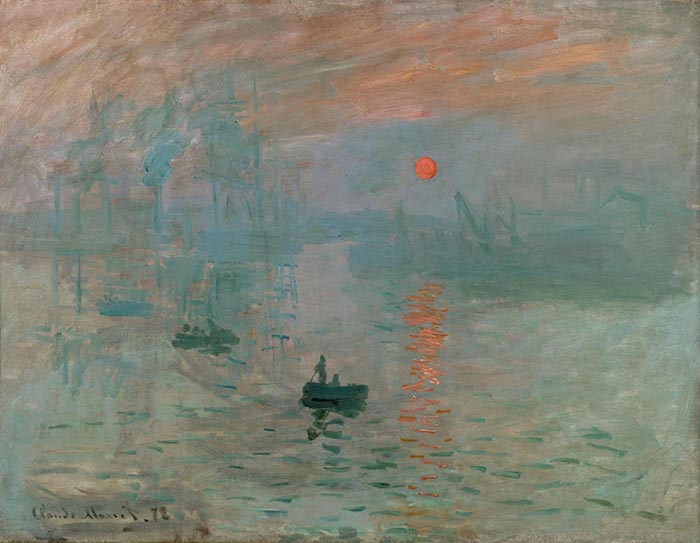
Claude Monet, Impression, Sunrise, 1872
Dominion of Odds
The rule of odds is an idea that objects in odd numbers appear more interesting and natural than objects in even numbers. That is, a grouping of 3 birds appears more interesting than a group of ii or four birds. One of the reasons for this is that even numbers can appear overly symmetrical.
Paul Cézanne demonstrates this idea in many of his still lifes.

Paul Cézanne, The Iii Skulls, 1900
Below is an one-time painting of mine, Iii Boats at Kingfisher Bay. What would the painting look similar with only ii boats? Awkward I think.
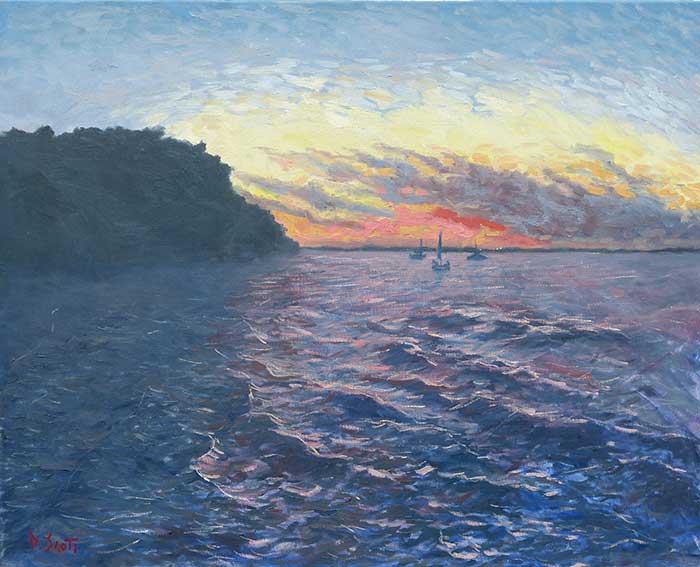
Dan Scott, Iii Boats at Kingfisher Bay, 2016
Tip: If your subject has an fifty-fifty-numbered group of objects, consider calculation or excluding some to brand it an odd number. For example, if at that place are two birds in the sky of your mural, consider adding a third. But, be careful not to venture likewise far from your reference.
Triangles
This one is related to the rule of odds. Triangular arrangements are considered to be aesthetically pleasing. Perhaps due to the natural asymmetry. And if the triangle is upright, there's a powerful sense of structure and stability (recollect of the Egyptian pyramids). In Cézanne'due south still life below, notice the triangular shape of the flowers and vase. A key takeaway here is that you can arrange dissimilar objects into a vague, triangular shape. You don't need to smack viewers over the head with a triangle. Less is often more in painting.

Paul Cézanne, Yet Life Flowers in a Vase, 1888
I adopted a triangular theme in Wellington Bespeak, Shimmering light. Consider what the composition would look like with a rectangular foreground. I imagine it would expect blocky and flat. One of the benefits of a triangular theme like this is that you lot tin easily lead from one area to the next.

Dan Scott, Wellington Indicate, Shimmering Low-cal, 2021
The "rules" of composition are anything but that. They exist for a reason in that they make sense most of the time, just there volition be times when y'all should ignore them and follow your gut.
Further, if anybody followed the composition rules to the T, we would all paint the same. And what would be the fun in that?
For every rule, at that place's a bright painting that breaks it. Take Abram Arkhipov'southward Smiling Girl (beneath). The subject's caput comes to the height edge of the painting. You typically would push the subject down and take some negative infinite at the top. But it works in this case equally it plays into the painting's intimate feel.

Abram Arkhipov, Smiling Girl
I provide a detailed listing of examples in this mail: Paintings That Break the Composition Rules.
Since starting Draw Pigment Academy, I accept had the privilege of seeing thousands of student paintings. I put together a listing of the most common bug and areas for comeback I see. Keep in mind, a mistake in i painting might exist a success in another. Composition is tricky like that. So again, treat these as gentle suggestions rather than strict rules.
Focal Betoken on the Edge of the Painting
Your focal betoken is the fundamental feature or idea of your painting. Information technology should be in a prominent spot, not on the edges.
Aligning Objects
Information technology tin wait unnatural if the tallest tree in your landscape aligns with the peak of the distant mountain.
Besides Much Noise
Don't try to pigment every color, value, texture, highlight, or shadow. Simplify. Y'all'll stop up with a more than cohesive painting.
Bromidic
It's hard to make a composition work if it doesn't start with some kind of spark or idea.
Horizon Line Right in the Centre
Not a large consequence, but you should usually requite dominance to the sky or land.
Too Many Direct Lines (Particularly in Landscapes)
Straight lines are rigid and tight. Comprehend curves. As Steve Huston wrote in his Figure Drawing for Artists (page 38):
"The world is full of watery design lines. Just look around."
Pushing in the Wrong Direction
If you're going to exaggerate whatsoever elements in your painting, information technology'due south amend to push in the direction of your big idea. It's better to brand your vivid sunset a bit warmer. It's better to make your rigid cityscape a bit straighter. It's meliorate to make your stormy seascape a bit darker and the waves a bit larger.
Unnecessary Objects
If something doesn't add to the composition, does information technology demand to exist in that location?
Leading Lines Out of the Painting
Lines are powerful. Our optics like to follow them. Be conscientious not to lead people out of your painting.
Drove of Parts
Your goal is to create a beautiful painting, not a drove of beautifully painted parts. Focus on the big picture show and never lose sight of it.
Lost Opportunities
Look for opportunities to convey your ideas. Grass tin can exist used to convey direction and motility. Hair can be used to frame the confront. Highlights can be used to reiterate key structures. E'er call up about each function'southward role in the bigger picture.
Getting Caught up in Your Ain Ways
Avoid painting the aforementioned limerick over and over again. Modify it upwards. That's what I did in myTree in Perspective. Instead of painting a standard landscape, I looked upwards and painted from an unusual bending.
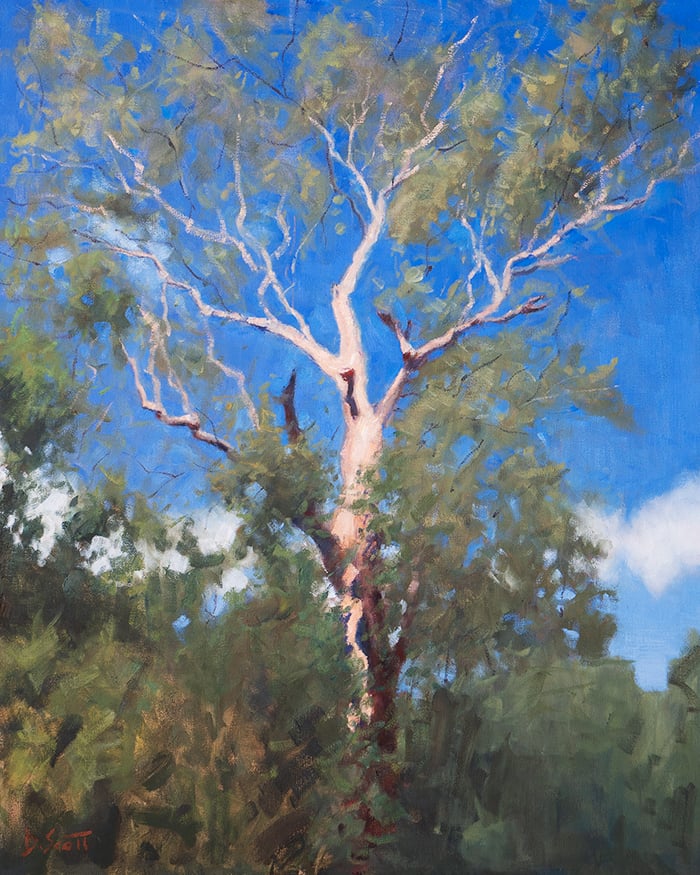
Dan Scott, Tree in Perspective, 2020
I put together a simple checklist that will aid you analyze master paintings (or your own). You tin download a copy here.
To requite you an idea of how to use the checklist, I used it to analyze myKobe painting. See beneath the painting, the checklist questions, and my answers:
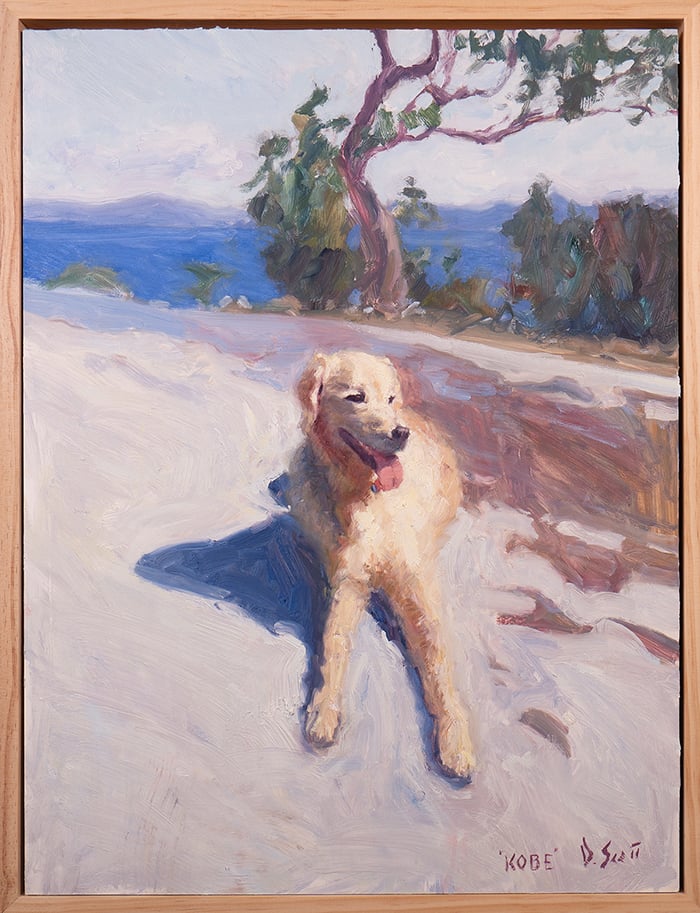
Dan Scott, Kobe, 2021
Storytelling: What is the artist trying to say? What is the story? (Tip: Think well-nigh the visual journey your eyes take through the painting. Where does the artist lead you?)
This painting was a gift to my beautiful partner Chontele. She merely turned 30. We consider Kobe to be our first kid, so the pressure level was on to paint him well!
The story is unproblematic: to capture Kobe's smiling and good nature.
Focal Betoken: Is in that location a dominant focal bespeak? Where is information technology? How does the creative person draw your attention towards it?
Yes, Kobe!
I draw attention to him through positioning, particular, and contrast.
Secondary Focal Points: Are there any secondary focal points? What is their purpose?
The landscape is a secondary focal signal. The idea is to show Kobe in nature, rather than Kobe by himself.
Kobe loves to be around people and nature, but he doesn't similar the spotlight. A typical pet portrait wouldn't be suitable.
Framing: Are there any elements that frame function of the painting?
The greenery and ocean frame the top of the painting. The water on the basis and its reflections frame Kobe on the right-hand side.
Movement / Leading Lines: Is there a sense of movement or activity? What is the nature of that movement?
Information technology's a still painting, other than Kobe'due south panting and fur blowing.
Balance: Does the painting feel balanced? Practice whatsoever parts feel stronger or heavier than the residue of the painting? (Tip: Remember, a modest, busy space can have the same bear on as a large, serenity space.)
Yes, it feels balanced to me.
Kobe takes upwards a small part of the painting, only he draws most of the attending.
The summit half of the painting is balanced confronting the bottom half of the painting. The height half has the tree, bushes, mountains, water, and sky. The bottom half has Kobe.
Linked Elements: Are there subtle links betwixt carve up areas of the painting?
The low-cal parts of Kobe link with the light parts of the pavement.
The class shadow links with the bandage shadow.
The blue reflection of the water on the pavement leads you towards the deep-blue ocean (a subtle, cleaved link).
Visual Brushwork: Is visual brushwork a key feature of the painting? Does the artist use visual brushwork to convey the nature of the subject area?
I used thick brushwork to paint Kobe'southward fur, particularly in the lights. I didn't effort to paint every strand of hair, rather I let the visible brushwork do most of the work.
Big Shapes: What are the large, dominant shapes?
The landscape is fabricated upward of big, unproblematic shapes. Kobe is made up of more intricate shapes.
Simplification: What areas take been simplified? What areas are detailed?
The landscape is simple. Kobe is detailed. But remember, painting is relative. If we narrow downwards on simply Kobe, we can see his face up is detailed and the rest of his body is unproblematic.
The best fashion to larn composition is to analyze master paintings and detect why they work and what you might do amend. This will help you acquire the linguistic communication of limerick.
Let's run through some master painting examples plus some fundamental observations in terms of composition.
Sir Arthur Streeton,Australia Felix. Depth is the focus of this painting. Notice the tight foreground at the bottom and the color gradation as everything recedes into the distance.
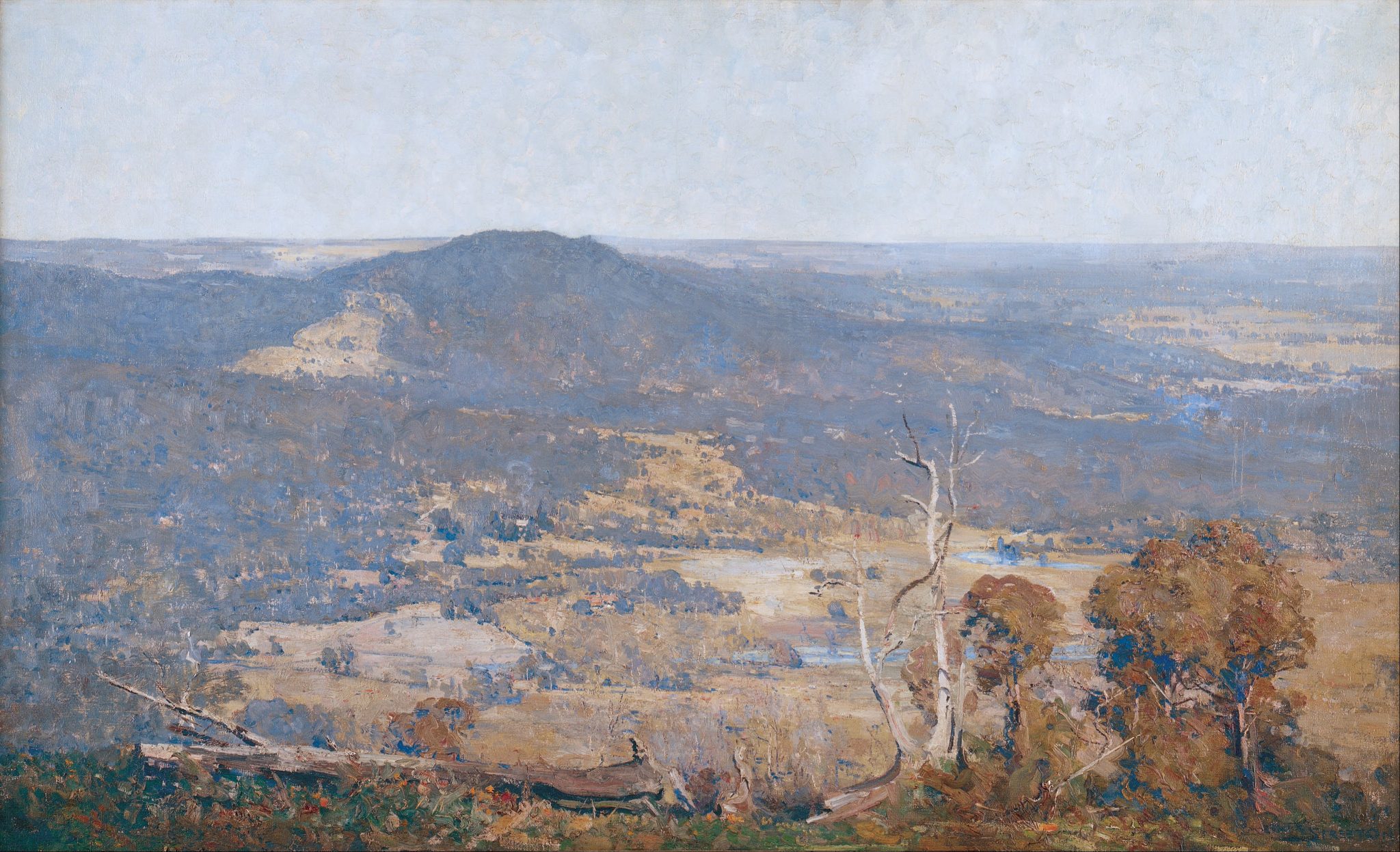
Arthur Streeton, Australia Felix, 1907
Anna Althea Hills, Sea View. Nature frames the high-key background. There's a powerful contrast between the foreground and background. Dark against light, rich against tinted, complex confronting simple.

Anna Althea Hills, Sea View
Camille Pissarro, The Boulevard Montmartre on a Wintertime Morning. A complex limerick with many moving parts. Simplification plays an important role. Pissarro didn't paint every tedious detail. He simplified and tuned out most of the "noise". The architecture creates a powerful sense of linear and atmospheric perspective (the buildings, cars, and people appear to get smaller and fainter every bit they recede into the distance).
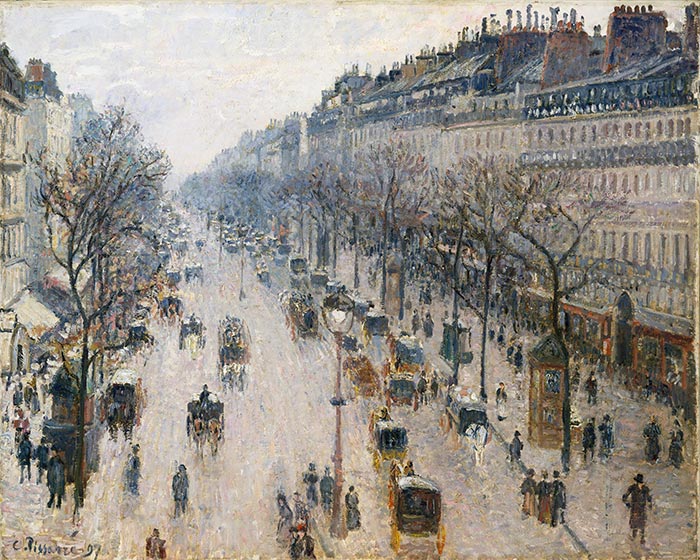
Camille Pissarro, The Boulevard Montmartre on a Winter Morning, 1897
Anders Zorn, Emma Zorn Reading. An intimate composition with a narrow depth of field. The subject area doesn't announced to be aware of our presence. It's a aboveboard scene. Value contrast is used to focus our attention on the subject. Her line of vision is a powerful unsaid line. What news is she reading about?
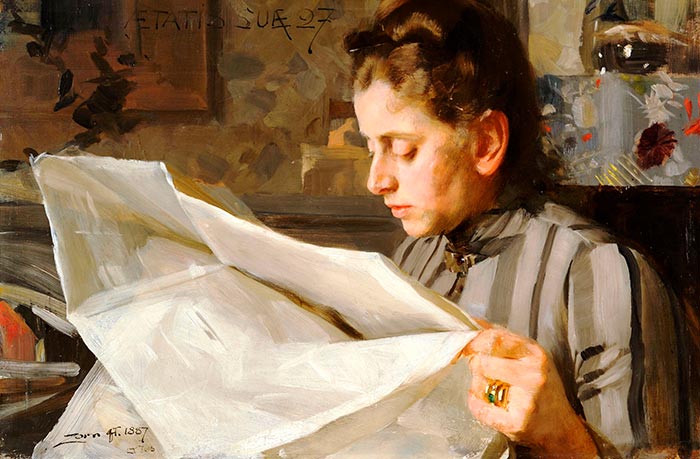
Anders Zorn, Emma Zorn Reading, 1887
John Singer Sargent,Siesta. A relaxed composition with two people taking a siesta amongst nature. The vantage point creates an interesting play in terms of perspective and depth. This is also a nifty study of gesture and structure.
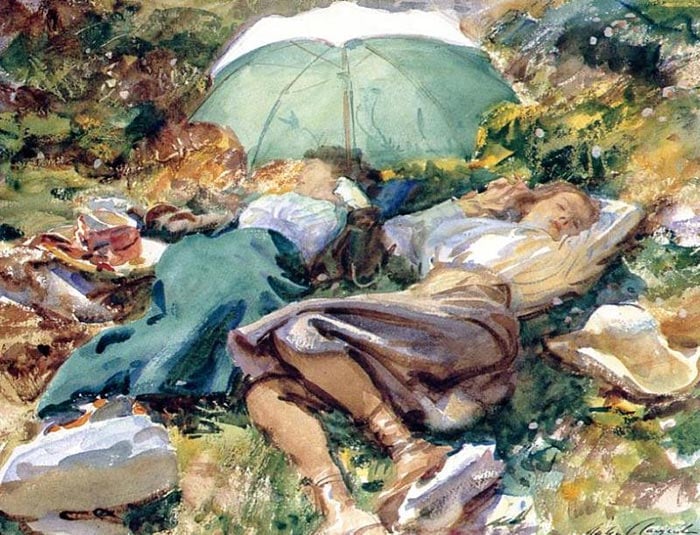
John Singer Sargent, Siesta, 1907


John Vocalist Sargent, Reconnoitering. A powerful focal betoken with an ambient background. Difficult edges separate the subject from the background, creating a sense of depth. Contrast focuses our attending on the subject field. The residuum of the painting is simplified in terms of value and particular. His line of vision is an implied line. It doesn't pb united states of america to anywhere in detail, which reiterates the idea of his afar stare.
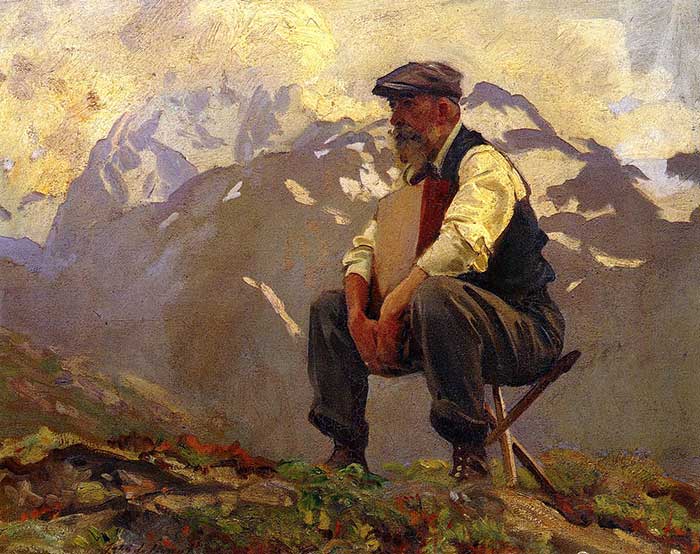
John Vocalizer Sargent, Reconnoitering, 1911
Valentin Serov, Girl With Peaches. This is similar to Zorn'due southEmma Zorn Reading, simply in this case, the bailiwick is looking right back at usa. Notice how this changes the composition. Her eyes command our attention.

Valentin Serov, Girl With Peaches, 1887
Nikolay Bogdanov-Belsky, The Daughter in the Forest. This breaks one of the composition "rules", in that the subject area is looking to the side, directing our attention out of the painting. But, it works as it emphasizes her distant stare.

Nikolay Petrovich Bogdanov-Belsky, The Girl in the Woods
Vincent van Gogh, Garden Coin With Butterflies. Van Gogh was certainly not independent by rules and standards. His compositions are diverse. I particularly similar how he was able to inject life and movement into simple compositions. Look at the energy in his strokes.
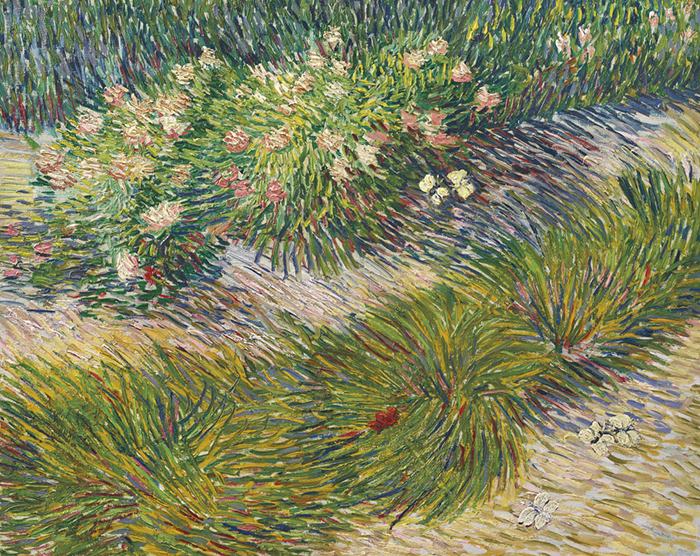
Vincent van Gogh, Garden Coin With Collywobbles, 1887
Hither are some of the key takeaways from this mail service:
- "Good composition is like a break bridge - each line adds strength and takes none away." Robert Henri
- It helps to distill all the rules and theories down to 2 unproblematic questions: What are you trying to say? How are you lot going to say it?
- Composition is not the aforementioned as copying the reference. As the artist, you have the license to ignore, add or modify the reference as needed.
- The visual elements are the edifice blocks of limerick. The principles of art are the mucilage holding information technology all together.
- Be conscientious not to get caught up in all the composition terms. They merely assist us articulate and sympathise composition. You don't demand to memorize all the terms in society to craft beautiful compositions.
- The techniques, rules, and theories exist for a reason in that they work most of the time. But do non follow them as rule-bound police.

Edgar Payne, Brittany Boats
Want to Acquire More than?
If you enjoyed this post, you should check out Composition Breakdown. Information technology's an 8-week deep-dive where you lot'll learn how to arts and crafts more than interesting compositions. You'll get a gamble to break down xx master paintings and apply what you lot learned today.
Thanks for Reading!
Thanks for taking the time to read this post. I appreciate it! Feel free to share with friends.
Happy painting!

Dan Scott
Draw Paint Academy
Source: https://drawpaintacademy.com/understanding-composition-for-artists/
0 Response to "What Is the Strongest Type of Compositional Path in Art History"
Post a Comment